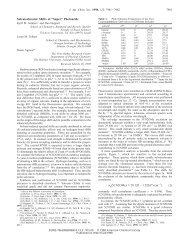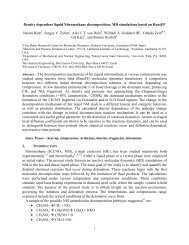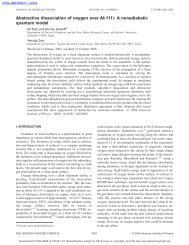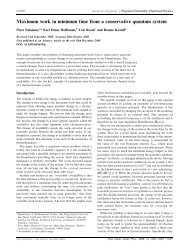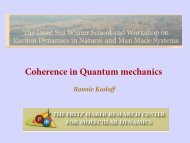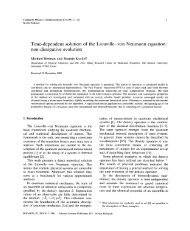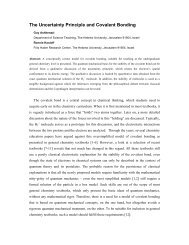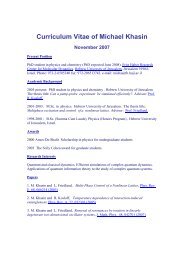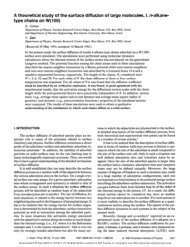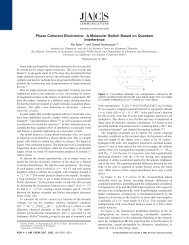Investigating pure vibrational dephasing of I in solution ...
Investigating pure vibrational dephasing of I in solution ...
Investigating pure vibrational dephasing of I in solution ...
You also want an ePaper? Increase the reach of your titles
YUMPU automatically turns print PDFs into web optimized ePapers that Google loves.
JOURNAL OF CHEMICAL PHYSICS VOLUME 118, NUMBER 8 22 FEBRUARY 2003<br />
À<br />
<strong>Investigat<strong>in</strong>g</strong> <strong>pure</strong> <strong>vibrational</strong> <strong>dephas<strong>in</strong>g</strong> <strong>of</strong> I3 <strong>in</strong> <strong>solution</strong>: Temperature<br />
dependence <strong>of</strong> T2 * for the fundamental and first harmonic <strong>of</strong> 1 Erez Gershgoren, Zhaohui Wang, and Sanford Ruhman a)<br />
Department <strong>of</strong> Physical Chemistry and the Farkas Center for Light Induced Processes,<br />
The Hebrew University, Jerusalem 91904, Israel<br />
Jiri Vala and Ronnie Kosl<strong>of</strong>f a)<br />
Department <strong>of</strong> Physical Chemistry, and The Fritz Haber Center for Chemical Dynamics, The Hebrew<br />
University, Jerusalem 91904, Israel University, 91904, Israel<br />
Received 2 August 2002; accepted 27 November 2002<br />
Pure 1 <strong>vibrational</strong> <strong>dephas<strong>in</strong>g</strong> <strong>of</strong> triiodide is recorded <strong>in</strong> ethanol and methyl-tetrahydr<strong>of</strong>urane<br />
<strong>solution</strong>s from 300 to 100 K, for the <strong>vibrational</strong> fundamental and its first overtone. Us<strong>in</strong>g impulsive<br />
Raman spectroscopy, <strong>dephas<strong>in</strong>g</strong> is demonstrated to be homogeneous throughout the temperature<br />
range studied. Independent measures <strong>of</strong> T1 prove that population relaxation contributes negligibly<br />
to the <strong>dephas<strong>in</strong>g</strong> rates. The reduction <strong>in</strong> temperature gradually leads to a 2-fold decrease <strong>in</strong> the rate<br />
<strong>of</strong> <strong>pure</strong> <strong>dephas<strong>in</strong>g</strong>. With cool<strong>in</strong>g the ratio <strong>of</strong> T* 2(n1) /T* 2(n2) reduces slightly but rema<strong>in</strong>s <strong>in</strong> the<br />
range <strong>of</strong> 2.7 to 2. These results are discussed <strong>in</strong> terms <strong>of</strong> Kubo l<strong>in</strong>eshape and Poisson <strong>dephas<strong>in</strong>g</strong><br />
theories. Neither <strong>of</strong> these consistently expla<strong>in</strong>s the experimental observations assum<strong>in</strong>g reasonable<br />
<strong>in</strong>tensities and rates <strong>of</strong> <strong>in</strong>termolecular encounters <strong>in</strong> the <strong>solution</strong>s. © 2003 American Institute <strong>of</strong><br />
Physics. DOI: 10.1063/1.1539844<br />
I. INTRODUCTION<br />
Vibrational relaxation is a subject <strong>of</strong> both practical and<br />
conceptual importance. It is the key to vital stages <strong>of</strong> chemical<br />
reactivity, such as thermal activation <strong>of</strong> transitions between<br />
stable ground state molecular structures, and the subsequent<br />
dispersal <strong>of</strong> excess energy and stabilization <strong>of</strong> the<br />
reactants. 1 Conceptually, it provides a critical test<strong>in</strong>g ground<br />
for theoretical models for <strong>in</strong>termolecular <strong>in</strong>teractions <strong>in</strong> condensed<br />
phases. 2 Accord<strong>in</strong>gly, IR and Raman l<strong>in</strong>eshapes, 3 as<br />
well as ultrafast laser spectroscopy, 4,5 have been applied to<br />
record <strong>vibrational</strong> energy and phase relaxation <strong>of</strong> molecular<br />
solutes. Even <strong>in</strong> the limited context <strong>of</strong> relaxation <strong>in</strong>volv<strong>in</strong>g<br />
the lowest rungs <strong>of</strong> a <strong>vibrational</strong> ladder, analysis <strong>of</strong> experimental<br />
results can prove challeng<strong>in</strong>g. To beg<strong>in</strong> with, energy<br />
and phase relaxation are <strong>in</strong>tertw<strong>in</strong>ed, through the wellknown<br />
relation<br />
1/T21/2T11/T2 * , 1<br />
where T2 and T2 * represent observed and <strong>pure</strong> <strong>dephas<strong>in</strong>g</strong><br />
times, respectively, and T1 is the <strong>in</strong>verse rate <strong>of</strong> population<br />
decay. It is therefore almost always necessary to <strong>in</strong>vestigate<br />
both processes <strong>in</strong> order to del<strong>in</strong>eate the various contributions<br />
to the l<strong>in</strong>ewidth or equivalently to the <strong>dephas<strong>in</strong>g</strong> time when<br />
measured directly.<br />
In liquids, <strong>pure</strong> <strong>dephas<strong>in</strong>g</strong> <strong>of</strong>ten dom<strong>in</strong>ates the decay <strong>of</strong><br />
<strong>vibrational</strong> coherence. It is almost universally described <strong>in</strong><br />
terms <strong>of</strong> a stochastic model, assum<strong>in</strong>g that solvent-<strong>in</strong>duced<br />
shifts <strong>in</strong> the <strong>vibrational</strong> frequency v cause the oscillators to<br />
lose step with each other. The distribution <strong>of</strong> local solvent<br />
arrangements is envisioned to generate a Gaussian spread <strong>of</strong><br />
a<br />
Authors to whom correspondence should be addressed. Electronic mail:<br />
sandy@fh.huji.ac.il<br />
<strong>in</strong>stantaneous frequencies, characterized by a rms width <strong>of</strong> .<br />
The solvent motions <strong>in</strong>duce spectral diffusion that effectively<br />
randomizes the oscillator frequency on a characteristic average<br />
time scale c . After assum<strong>in</strong>g that the spectral modulation<br />
is a Gaussian process, the results <strong>of</strong> the analysis are as<br />
follows: When the spectral diffusion is much slower than 1/<br />
( c1), the coherence decay is Gaussian, dictated by<br />
static <strong>in</strong>homogeneous broaden<strong>in</strong>g accord<strong>in</strong>g to Eq. 2,<br />
QtQ0expt 2 2 /2 2<br />
where Q is the displacement coord<strong>in</strong>ate. At the other extreme,<br />
when c1, extensive spectral diffusion is go<strong>in</strong>g on<br />
before the phase is washed out, the <strong>vibrational</strong> coherence<br />
will be erased exponentially Lorentzian l<strong>in</strong>eshape, accord<strong>in</strong>g<br />
to<br />
QtQ0exp 2 t c. 3<br />
This is the ‘‘motional narrow<strong>in</strong>g,’’ or ‘‘fast modulation’’ limit<br />
<strong>of</strong> the model, orig<strong>in</strong>ally formulated by Kubo 6 to expla<strong>in</strong><br />
magnetic resonance data, and later adapted to <strong>vibrational</strong> relaxation<br />
by Oxtoby. 2 In the midrange between the two, a<br />
hybrid dynamics <strong>of</strong> <strong>dephas<strong>in</strong>g</strong> is predicted start<strong>in</strong>g out<br />
Gaussian, and revert<strong>in</strong>g to an exponential tail at longer<br />
delays. 7 When the autocorrelation <strong>of</strong> the frequency is assumed<br />
to decay exponentially (C e t/c ), this range can<br />
be described analytically:<br />
QtQtexp 2 c 2 e t/ c1t c, 4<br />
consistently breach<strong>in</strong>g the limits <strong>of</strong> <strong>in</strong>homogeneous and homogeneous<br />
broaden<strong>in</strong>g.<br />
0021-9606/2003/118(8)/3660/8/$20.00 3660<br />
© 2003 American Institute <strong>of</strong> Physics<br />
Downloaded 10 Feb 2003 to 132.64.1.37. Redistribution subject to AIP license or copyright, see http://ojps.aip.org/jcpo/jcpcr.jsp
J. Chem. Phys., Vol. 118, No. 8, 22 February 2003 Vibrational <strong>dephas<strong>in</strong>g</strong> <strong>of</strong> I 3 <strong>in</strong> <strong>solution</strong><br />
The model described above has proven most valuable <strong>in</strong><br />
rationaliz<strong>in</strong>g the microscopic mechanisms that underlie<br />
solvent-<strong>in</strong>duced <strong>pure</strong> <strong>dephas<strong>in</strong>g</strong>. With<strong>in</strong> its context predictions<br />
have been made concern<strong>in</strong>g the changes <strong>of</strong> T2 * with<br />
shifts <strong>in</strong> temperature, density, or viscosity. 8–10 For specific<br />
molecular systems the values <strong>of</strong> and <strong>of</strong> c have been determ<strong>in</strong>ed<br />
and compared with theoretical predictions. One<br />
prediction <strong>of</strong> this model that has not been as thoroughly<br />
tested deals with the relative <strong>pure</strong> <strong>dephas<strong>in</strong>g</strong> rates <strong>of</strong> <strong>vibrational</strong><br />
harmonics. The modulation mechanism must be <strong>in</strong>dependent<br />
<strong>of</strong> the observed harmonic and therefore c is identical<br />
for coherence at all harmonics <strong>of</strong> . The spread <strong>of</strong><br />
frequencies, however, is a different story, and does depend<br />
on n, the order <strong>of</strong> the measured coherence:<br />
nth harmonicnn•. 5<br />
2<br />
Thus, <strong>in</strong> the fast modulation limit, T2 *(n)1/n c<br />
1/2n 2 c , and depends quadratically on n. In the static<br />
limit, T2 *(n)1/n1/n, lead<strong>in</strong>g to a l<strong>in</strong>ear dependence.<br />
The exposition above predicts a quadratic dependence <strong>of</strong><br />
the rate <strong>of</strong> <strong>dephas<strong>in</strong>g</strong> on the harmonic order <strong>of</strong> the coherence<br />
<strong>in</strong> the fast modulation limit. Subquadratic behavior can also<br />
be expected, but only when the phase decay is clearly nonexponential.<br />
In that case, when neither <strong>of</strong> the limit<strong>in</strong>g cases<br />
dom<strong>in</strong>ates the dynamics, no clear def<strong>in</strong>ition <strong>of</strong> a ‘‘<strong>dephas<strong>in</strong>g</strong><br />
time’’ exists. Strangely enough, <strong>in</strong> the majority <strong>of</strong> cases<br />
tested, a subquadratic dependence <strong>of</strong> T2 * on n has been<br />
obta<strong>in</strong>ed, 11–13 even when the conditions for fast modulation<br />
were demonstrated to hold, and exponential phase decay was<br />
measured at all harmonics. 14 In a recent paper, Gayathri<br />
et al. have tried to provide a mechanistic explanation with<strong>in</strong><br />
the Kubo l<strong>in</strong>eshape model to subquadratic n dependence <strong>of</strong><br />
molecular nitrogen <strong>in</strong> various thermodynamic states, suggest<strong>in</strong>g<br />
that coupl<strong>in</strong>g <strong>of</strong> vibration and rotation provides an<br />
additional <strong>in</strong>homogeneous contribution to the broaden<strong>in</strong>g,<br />
not taken <strong>in</strong>to consideration <strong>in</strong> the usual application <strong>of</strong> the<br />
theory. 15 A multiphased decay <strong>of</strong> (0)(t), the<br />
frequency—frequency time autocorrelation function, over<br />
separable and very disparate phases <strong>in</strong> time, was also discussed<br />
as a mechanism for the nonideal relative <strong>dephas<strong>in</strong>g</strong><br />
rates.<br />
An alternative <strong>in</strong>terpretation <strong>of</strong> the observations described<br />
above is presented <strong>in</strong> a theoretical study by<br />
Yamaguchi. 16 A model is formulated where collisions <strong>in</strong> the<br />
liquid can <strong>in</strong>duce sudden phase jumps <strong>in</strong> the vibrations, and<br />
rather than be<strong>in</strong>g the results <strong>of</strong> many slight modulations, justify<strong>in</strong>g<br />
the Gaussian approximation, the phase relaxation is<br />
the result <strong>of</strong> uncorrelated and large changes <strong>of</strong> <strong>vibrational</strong><br />
phase. Mathematically this leads to Poisson <strong>dephas<strong>in</strong>g</strong> dynamics.<br />
This model is also characterized by two parameters,<br />
an average rate <strong>of</strong> phase chang<strong>in</strong>g <strong>in</strong>teractions (1/i), and the typical size <strong>of</strong> the jump <strong>in</strong> phase ( 0). Two additional<br />
assumptions are applied, as presented <strong>in</strong> Eq. 6:<br />
Pe / 0/ 0 , for 0 6a<br />
.<br />
and P0, for 0 6b<br />
P im,t 1<br />
m! t<br />
i e t/ i<br />
The exponential distribution <strong>of</strong> phase jumps reflects their<br />
thermally activated nature, and Eq. 6b describes the probability<br />
<strong>of</strong> our solute experienc<strong>in</strong>g m collisions with<strong>in</strong> time<br />
span t.<br />
The result<strong>in</strong>g <strong>dephas<strong>in</strong>g</strong> dynamics differ markedly from<br />
the Kubo model. First, phase relaxation is always exponential.<br />
Second, the <strong>dephas<strong>in</strong>g</strong> rates <strong>of</strong> harmonics range from<br />
quadratic n dependence when the jumps are small back to<br />
the Gaussian regime, to zero n dependence when the jumps<br />
are large. At this limit, the collisions are so potent that each<br />
can totally elim<strong>in</strong>ate the solute molecule from contribut<strong>in</strong>g to<br />
any <strong>of</strong> the harmonics. Thus, the <strong>dephas<strong>in</strong>g</strong> takes place at all<br />
harmonics at a rate that is identical to the rate <strong>of</strong> these catastrophic<br />
collisions. In terms <strong>of</strong> the parameters above, the<br />
<strong>pure</strong> <strong>dephas<strong>in</strong>g</strong> time result<strong>in</strong>g from the Poisson model is<br />
T 2 *n i⌊1n 2 0 2 ⌋<br />
n 2 0 2<br />
3661<br />
lead<strong>in</strong>g to a gradual transition between the limit<strong>in</strong>g <strong>dephas<strong>in</strong>g</strong><br />
behaviors as the average phase jump <strong>in</strong>creases.<br />
The molecular system under study here is the l<strong>in</strong>ear triiodide<br />
ion I 3 , which has been the subject <strong>of</strong> comb<strong>in</strong>ed experimental<br />
and theoretical study <strong>in</strong> our groups for some<br />
time. 17–19 Us<strong>in</strong>g impulsive photolysis, I 3 dissociation and<br />
recomb<strong>in</strong>ation dynamics were recorded <strong>in</strong> various polar molecular<br />
solvents. The solvent was found to <strong>in</strong>fluence reactivity<br />
not only by <strong>dephas<strong>in</strong>g</strong> nuclear motion and dissipat<strong>in</strong>g<br />
excess photon energy, but also by determ<strong>in</strong><strong>in</strong>g the <strong>in</strong>itial geometry<br />
and degree <strong>of</strong> symmetry <strong>of</strong> the reactant. 20–22 The<br />
ultrafast photoexcitation that served to vertically promote<br />
molecules onto the reactive surface, simultaneously generated<br />
<strong>vibrational</strong> coherences <strong>in</strong> the ground state through resonant<br />
impulsive stimulated Raman scatter<strong>in</strong>g RISRS, 23–25<br />
giv<strong>in</strong>g rise to spectral modulations observed <strong>in</strong> the UV absorption<br />
spectrum. Their decay provided a direct measure <strong>of</strong><br />
the ensu<strong>in</strong>g <strong>vibrational</strong> <strong>dephas<strong>in</strong>g</strong> between low <strong>vibrational</strong><br />
levels <strong>of</strong> the ion.<br />
In view <strong>of</strong> the central role played by the solvent <strong>in</strong> the<br />
photochemistry <strong>of</strong> this ion, a specific effort was made to ga<strong>in</strong><br />
detailed <strong>in</strong>sight <strong>in</strong>to static and dynamic aspects <strong>of</strong> triiodide<br />
solvation <strong>in</strong> polar liquids—based upon the RISRS observable.<br />
Start<strong>in</strong>g with the study <strong>of</strong> the RISRS process itself, and<br />
later apply<strong>in</strong>g this knowledge to unravel<strong>in</strong>g triiodide <strong>vibrational</strong><br />
dynamics, the follow<strong>in</strong>g discoveries were made.<br />
1 RISRS proved to be a facile method for characteriz<strong>in</strong>g<br />
ground state <strong>vibrational</strong> <strong>dephas<strong>in</strong>g</strong> at the bottom <strong>of</strong> the<br />
<strong>vibrational</strong> ladder.<br />
2 Fortuitous tun<strong>in</strong>g <strong>of</strong> pump and probe frequencies, or apply<strong>in</strong>g<br />
properly timed multiple excitation pulses allowed<br />
selective measurement <strong>of</strong> fundamental and overtone<br />
<strong>dephas<strong>in</strong>g</strong> times with high precision. Compar<strong>in</strong>g results<br />
with those reported from resonance Raman further<br />
proved RISRS to be the only method capable <strong>of</strong> reliable<br />
T 2 measurements for this system! 26<br />
3 Independent measures <strong>of</strong> T 1 demonstrate that <strong>pure</strong><br />
<strong>dephas<strong>in</strong>g</strong> dom<strong>in</strong>ates <strong>dephas<strong>in</strong>g</strong> <strong>in</strong> I 3 <strong>in</strong> all solvents<br />
studies. 27<br />
Downloaded 10 Feb 2003 to 132.64.1.37. Redistribution subject to AIP license or copyright, see http://ojps.aip.org/jcpo/jcpcr.jsp<br />
7
3662 J. Chem. Phys., Vol. 118, No. 8, 22 February 2003 Gershgoren et al.<br />
4 When studied <strong>in</strong> glass form<strong>in</strong>g liquids, from 300–100 K,<br />
homogeneous fundamental <strong>dephas<strong>in</strong>g</strong> was observed<br />
throughout. The <strong>dephas<strong>in</strong>g</strong> times <strong>in</strong>creased gradually by<br />
a factor <strong>of</strong> 2 over the range, despite the drastic changes<br />
to viscosity. 28<br />
5 T* 2(n1) /T* 2(n2) 2.5 for both ethanol and acetonitrile<br />
at 300 K. 26<br />
In the present study we <strong>in</strong>vestigate the mechanisms for<br />
the deviation <strong>of</strong> fundamental and harmonic <strong>pure</strong> <strong>dephas<strong>in</strong>g</strong><br />
times from the predictions <strong>of</strong> Kubo l<strong>in</strong>eshape theory. In par-<br />
ticular, T 2(n1)<br />
* /T 2(n2)<br />
* was measured as a function <strong>of</strong> tem-<br />
perature, throughout the range from room temperature to that<br />
<strong>of</strong> glass formation. The next section is dedicated to present<strong>in</strong>g<br />
the two theories outl<strong>in</strong>ed above on an equal foot<strong>in</strong>g, <strong>in</strong><br />
order to expose the molecular consequences <strong>of</strong> the mathematical<br />
assumptions and to expla<strong>in</strong> the motivation <strong>of</strong> our<br />
experiments. Follow<strong>in</strong>g the experimental section, our results<br />
will be presented and analyzed <strong>in</strong> terms <strong>of</strong> both models. The<br />
apparent <strong>in</strong>adequacy <strong>of</strong> both <strong>in</strong> expla<strong>in</strong><strong>in</strong>g our results will be<br />
presented and discussion.<br />
II. THEORY<br />
While the general approach represented by Yamaguchi’s<br />
stochastic model is adopted, it will first be reformulated, as a<br />
consistent quantum dynamical theory. The advantages <strong>of</strong><br />
such an approach are a that from it all the physical observables<br />
<strong>of</strong> the system can be evaluated, and b the simulation<br />
<strong>of</strong> <strong>in</strong>herently quantum mechanical variables, such as changes<br />
<strong>in</strong> time <strong>of</strong> molecular absorption and emission are possible.<br />
This requires abandon<strong>in</strong>g a weak coupl<strong>in</strong>g approach, s<strong>in</strong>ce it<br />
necessarily leads to Gaussian dynamics. One such approach,<br />
<strong>in</strong>spired by the exponential <strong>vibrational</strong> <strong>dephas<strong>in</strong>g</strong>, is to describe<br />
the open system by the Quantum Master equation. In<br />
this case the state <strong>of</strong> the system is characterized by the density<br />
operator <strong>of</strong> the primary system subject to the equation<br />
<strong>of</strong> motion:<br />
i<br />
<br />
t H,L D, 8<br />
where H represents the Hamiltonian <strong>of</strong> the systems and LD the dissipative bath contribution, which <strong>in</strong> L<strong>in</strong>dblads semigroup<br />
form becomes 29<br />
L D i<br />
F iF i 1/2FiF i ,, 9<br />
where F i are a operators from the Hilbert space <strong>of</strong> the primary<br />
system represent<strong>in</strong>g the dissipative force due to the<br />
bath. The dist<strong>in</strong>ction between the Hamiltonian dynamics and<br />
the dissipative part is not unique, which reflects the fact that<br />
the boundary between the system and the bath is arbitrary.<br />
The Hilbert space <strong>of</strong> the system has to <strong>in</strong>clude all the operators<br />
represent<strong>in</strong>g observables. It is customary to <strong>in</strong>clude part<br />
<strong>of</strong> the bath explicitly. This allows one to describe effects<br />
such as <strong>in</strong>homogeneous broaden<strong>in</strong>g and spectral diffusion.<br />
The approach is <strong>in</strong> analogy with the Brownian oscillator,<br />
where a collective over a damped bath coord<strong>in</strong>ate is <strong>in</strong>cluded<br />
explicitly. 30<br />
In light <strong>of</strong> the experimental observations, the paved road <strong>of</strong> a<br />
perturbation expansion assum<strong>in</strong>g a weak coupl<strong>in</strong>g between<br />
the system and the bath is abandoned to a strong coupl<strong>in</strong>g<br />
description. This requirement elim<strong>in</strong>ates the approach based<br />
on a classical calculation <strong>of</strong> bath correlation functions. For<br />
the quantum case only two strong coupl<strong>in</strong>g limit<strong>in</strong>g cases<br />
have been worked out. The analysis focuses on elastic system<br />
bath encounters for which L D *(H)0 19 where L D * is the<br />
dissipative superoperator <strong>in</strong> the Heisenberg representation.<br />
At this po<strong>in</strong>t we should try to classify the orig<strong>in</strong> <strong>of</strong> these<br />
system bath elastic encounters. One possibility is that the<br />
<strong>dephas<strong>in</strong>g</strong> is the result <strong>of</strong> the accumulation <strong>of</strong> rare uncorrelated<br />
events, i.e., a Poisson model. Each <strong>of</strong> these events can<br />
be described by a scatter<strong>in</strong>g operator S such that after a<br />
s<strong>in</strong>gle event the state <strong>of</strong> the system is changed to SS . The<br />
total dissipative rate <strong>of</strong> change under a flow <strong>of</strong> uncorrelated<br />
scatter<strong>in</strong>g events with a rate 1/ i is then<br />
˙ DSS . 10<br />
The Poisson model fits L<strong>in</strong>dblads form if we identify the<br />
operator F <strong>in</strong> Eq. 9 with S. 29,31 The simplest <strong>pure</strong><br />
<strong>dephas<strong>in</strong>g</strong> scatter<strong>in</strong>g operator that does not alter the energy<br />
<strong>of</strong> the system is the phase shift operator Se i/hH , where<br />
is the elastic phase shift characteriz<strong>in</strong>g the scatter<strong>in</strong>g event.<br />
The accumulation <strong>of</strong> these phase shifts generates the <strong>dephas<strong>in</strong>g</strong><br />
process lead<strong>in</strong>g to the equation <strong>of</strong> motion:<br />
i<br />
<br />
t H,ei/hH,* I, 11<br />
where H,*AH,A), which <strong>in</strong> the energy representation<br />
<strong>of</strong> the density operator becomes<br />
nm<br />
t i nm nme i nm 1 nm , 12<br />
where nm(E nE m)/ is the Bohr frequency. In the harmonic<br />
case nm(nm). It is obvious <strong>in</strong> Eq. 12 that<br />
only the <strong>of</strong>f-diagonal terms <strong>of</strong> the density operator decay.<br />
The simple Poisson model can be augmented by assum<strong>in</strong>g a<br />
distribution <strong>of</strong> scatter<strong>in</strong>g events weighted by P(), the probability<br />
density <strong>of</strong> a phase shift . The l<strong>in</strong>earity <strong>of</strong> the Semigroup<br />
equations <strong>of</strong> motion allow averag<strong>in</strong>g, lead<strong>in</strong>g to<br />
i<br />
<br />
t H, Pde i/H,* I .<br />
13<br />
We employ a symmetrized version <strong>of</strong> phase jump probability<br />
distribution <strong>of</strong> the exponential distribution <strong>of</strong> Yamaguchi,<br />
Eq. 6, i.e.,<br />
P 0e / 0. 14<br />
The exponential distribution <strong>of</strong> phase jump fits the assumption<br />
that the process is activated, i.e., the phase jump is determ<strong>in</strong>ed<br />
by the energy E c <strong>of</strong> the collision event 0<br />
E c /k BT. The symmetric version elim<strong>in</strong>ates the frequency<br />
shift associated with the process. A different viewpo<strong>in</strong>t is to<br />
assume that the rate <strong>of</strong> events is activated and that the<br />
phase jump distribution is normal:<br />
Downloaded 10 Feb 2003 to 132.64.1.37. Redistribution subject to AIP license or copyright, see http://ojps.aip.org/jcpo/jcpcr.jsp
J. Chem. Phys., Vol. 118, No. 8, 22 February 2003 Vibrational <strong>dephas<strong>in</strong>g</strong> <strong>of</strong> I 3 <strong>in</strong> <strong>solution</strong><br />
P 1<br />
2 e2 /2 2<br />
. 15<br />
For the normal distribution, the averag<strong>in</strong>g <strong>in</strong> Eq. 13 can be<br />
carried out explicitly, lead<strong>in</strong>g to<br />
i<br />
<br />
t H,e2 /2 2 †H,H,*‡ I, 16<br />
which <strong>in</strong> the energy representation becomes<br />
nm t i nmnme 2 2<br />
/2 nm<br />
1 nm . 17<br />
For the harmonic <strong>dephas<strong>in</strong>g</strong> case with a frequency , Eq.<br />
17 leads to<br />
T 2n<br />
i e 2 /2n 2 2<br />
1<br />
. 18<br />
The exponential distribution, Eq. 15, leads to a different<br />
decay pattern:<br />
nm t i 2<br />
nm nmnm 2 2 nm , 19<br />
0nm which leads to the T2(n) relation <strong>of</strong> Yamaguchi, Eq. 7.<br />
An alternative strong coupl<strong>in</strong>g <strong>dephas<strong>in</strong>g</strong> model is based<br />
on the concept <strong>of</strong> the Hamiltonian <strong>of</strong> the primary system<br />
cont<strong>in</strong>uously modulated by the bath:<br />
HHft, 20<br />
where f (t) is the bath modulation function. A Guassian<br />
model is def<strong>in</strong>ed when the modulation function can be described<br />
by a Guassian stochastic process. For the harmonic<br />
case f (t) is <strong>in</strong>terpreted as the temporary frequency <strong>of</strong> the<br />
oscillator. The <strong>dephas<strong>in</strong>g</strong> is therefore a result <strong>of</strong> frequency<br />
modulation. In the fast modulation limit,<br />
and<br />
f tB 0<br />
f tftBtt; 21<br />
Eq. 21 leads to the follow<strong>in</strong>g L<strong>in</strong>dblads semigroup form: 32<br />
LD2 †H,H,‡, 22<br />
which <strong>in</strong> the energy representation becomes<br />
nm t i nmnm2 2<br />
nmnm . 23<br />
Equation 23 recovers the result that the <strong>dephas<strong>in</strong>g</strong> rate <strong>of</strong><br />
the nth harmonic is quadratic <strong>in</strong> n, i.e., T2(n)1/n2 2 2 .<br />
This result will also be obta<strong>in</strong>ed <strong>in</strong> the weak coupl<strong>in</strong>g limit.<br />
Compar<strong>in</strong>g the Gaussian <strong>dephas<strong>in</strong>g</strong> model Eq. 23 to the<br />
Poisson <strong>dephas<strong>in</strong>g</strong> model Eqs. 7 and 18, we f<strong>in</strong>d that<br />
1<br />
when the phase jumps are small, i.e., or 0 , the <strong>dephas<strong>in</strong>g</strong><br />
becomes the result <strong>of</strong> the accumulation <strong>of</strong> many small<br />
phase jumps naturally, lead<strong>in</strong>g to a Gaussian <strong>dephas<strong>in</strong>g</strong><br />
model, i.e., 2( 2 /2) for the normal distribution and<br />
2 2<br />
/ 0 for the exponential distribution. For a large<br />
1<br />
value <strong>of</strong> or 0 each event leads to complete randomization<br />
<strong>of</strong> phase, lead<strong>in</strong>g to<br />
nm<br />
t i nm nm nm , 24<br />
i.e., T 2(n)1/ is <strong>in</strong>dependent <strong>of</strong> n, and is proportional to<br />
the rate <strong>of</strong> collision events .<br />
Equations 20 and 24 represent the two limits <strong>of</strong> the<br />
Poisson model. For small jumps the <strong>dephas<strong>in</strong>g</strong> rate will scale<br />
quadratically with the energy gap nm and for large phase<br />
jumps the scal<strong>in</strong>g becomes <strong>in</strong>dependent <strong>of</strong> the energy difference.<br />
In addition, if the phase jump is activated we expect<br />
that the process will become more Gaussian at lower temperatures.<br />
If only the rate <strong>of</strong> events is activated we expect<br />
a slowdown <strong>of</strong> the <strong>dephas<strong>in</strong>g</strong> at lower temperature while<br />
ma<strong>in</strong>ta<strong>in</strong><strong>in</strong>g the Poisson character.<br />
III. EXPERIMENT<br />
3663<br />
The light pulses were generated <strong>in</strong> a 1 kHz homemade<br />
multipass amplified Ti sapphire laser system that is described<br />
<strong>in</strong> detail elsewhere. 26 The output <strong>of</strong> the 15 fs oscillator is<br />
stretched to 20 ps, and <strong>in</strong>jected <strong>in</strong>to a eight pass amplifier<br />
cavity, which is pumped with 10 mJ pulses from an <strong>in</strong>tracavity<br />
doubled Q-switched Nd:YLF laser. The ultimate output<br />
after compression consists <strong>of</strong> a tra<strong>in</strong> <strong>of</strong> 28 fs pulses,<br />
centered at 790 nm, conta<strong>in</strong><strong>in</strong>g 0.6 mJ <strong>of</strong> energy per pulse.<br />
Pump, push, and probe pulses were all derived by doubl<strong>in</strong>g<br />
portions <strong>of</strong> the amplified pulses <strong>in</strong> BBO crystals that were, at<br />
most, 100 thick, and were demonstrated to <strong>in</strong>troduce negligible<br />
pulse broaden<strong>in</strong>g.<br />
The samples were prepared as previously described, 26 <strong>in</strong><br />
ethanol and <strong>in</strong> 1-methyl THF. Ethanol samples were stoppered<br />
<strong>in</strong> 1 mm quartz cuvettes, which were pressed aga<strong>in</strong>st<br />
the cold f<strong>in</strong>ger <strong>of</strong> a closed cycle helium cryostat RMC.<br />
Methyl-THF samples were glove-box loaded <strong>in</strong>to a cell consist<strong>in</strong>g<br />
<strong>of</strong> two 2 mm thick sapphire w<strong>in</strong>dows crystran, and a<br />
0.5 mm teflon spacer. The <strong>in</strong>ternal volume was accessed<br />
through holes drilled <strong>in</strong> one sapphire flat, and both vacuum<br />
tightness around the holes, and thermal contact, were provided<br />
by <strong>in</strong>dium wire pressed between the alum<strong>in</strong>um cell<br />
holder and the w<strong>in</strong>dows. The sample temperature was read at<br />
the base <strong>of</strong> the cell, and actual <strong>solution</strong> temperatures were<br />
estimated to be with<strong>in</strong> 2° <strong>of</strong> these read<strong>in</strong>gs. The temperature<br />
was regulated by a Lake Shore 330 controller coupled to a<br />
DT-400 series diode sensor. Dur<strong>in</strong>g the irradiation the sample<br />
was translated alternately <strong>in</strong> Y and Z directions X be<strong>in</strong>g the<br />
direction <strong>of</strong> irradiation via a stepper motor actuated l<strong>in</strong>ear<br />
translation stage on a precision lab jack microcontrol. Rates<br />
<strong>of</strong> translation were demonstrated to elim<strong>in</strong>ate any local heat<strong>in</strong>g<br />
or sample bleach<strong>in</strong>g effects. Methods <strong>of</strong> data collection<br />
and automation were as described previously.<br />
The <strong>in</strong>tegrity <strong>of</strong> the cooled samples was monitored by<br />
absorption spectroscopy. A fiber bundle halogen lamp<br />
illum<strong>in</strong>ator–open electrode deuterium lamp comb<strong>in</strong>ation<br />
produced a stable and cont<strong>in</strong>uous irradiation source over the<br />
range <strong>of</strong> the triiodide UV absorption. Some scatter<strong>in</strong>g that<br />
built up at the lower edge <strong>of</strong> the temperature range <strong>in</strong>terfered<br />
with a quantitative determ<strong>in</strong>ation <strong>of</strong> sample concentrations.<br />
The positions and widths <strong>of</strong> the two <strong>in</strong>tense near-UV bands<br />
Downloaded 10 Feb 2003 to 132.64.1.37. Redistribution subject to AIP license or copyright, see http://ojps.aip.org/jcpo/jcpcr.jsp
3664 J. Chem. Phys., Vol. 118, No. 8, 22 February 2003 Gershgoren et al.<br />
FIG. 1. A comparison <strong>of</strong> experimental and simulated peak widths at various<br />
temperatures. An experimental spectrum is presented <strong>in</strong> the <strong>in</strong>set to demonstrate<br />
the quality <strong>of</strong> the fit provided by the sum <strong>of</strong> Gaussians, and to designate<br />
the peaks.<br />
were obta<strong>in</strong>ed by fitt<strong>in</strong>g the measured spectra to a superposition<br />
<strong>of</strong> three Gaussians bands plotted aga<strong>in</strong>st photon energy.<br />
IV. RESULTS<br />
The center <strong>of</strong> the I 3 absorption peaks red shifted, and<br />
the bands narrowed systematically upon cool<strong>in</strong>g. In order to<br />
uncover the mechanism for the spectral narrow<strong>in</strong>g observed<br />
<strong>in</strong> both solvents, a theoretical simulation <strong>of</strong> the spectra was<br />
conducted us<strong>in</strong>g model potentials that were described previously<br />
and used to simulate I 3 photochemistry. 18,19 Figure 1<br />
presents the widths predicted by the theory together with<br />
those obta<strong>in</strong>ed from the fitt<strong>in</strong>g. An example <strong>of</strong> a measured<br />
spectrum along with a nonl<strong>in</strong>ear least squares fit is presented<br />
<strong>in</strong> the <strong>in</strong>sert. The theoretical predictions lie slightly outside<br />
the error limits <strong>of</strong> the measured widths at room temperature,<br />
but the trends <strong>of</strong> change with temperature agree well with the<br />
experimental changes. Another noteworthy result is that the<br />
widths obta<strong>in</strong>ed <strong>in</strong> ethanol and <strong>in</strong> MTHF are identical with<strong>in</strong><br />
error. This is remarkable <strong>in</strong> view <strong>of</strong> the charged nature <strong>of</strong> the<br />
chromophore, and the marked difference <strong>in</strong> polarity and<br />
charge distribution for the two solvents. While ethanol is a<br />
very polar solvent, especially adept at stabiliz<strong>in</strong>g localized<br />
negative molecular charge, THF is a spar<strong>in</strong>gly polar solvent,<br />
which is better at stabiliz<strong>in</strong>g cations. In both solvents the<br />
width <strong>of</strong> the upper and lower energy transitions are essentially<br />
the same at the various measured temperatures.<br />
Another unusual aspect <strong>of</strong> the temperature-dependent<br />
spectra <strong>in</strong>volves the spectral shift<strong>in</strong>g <strong>of</strong> these peaks with<br />
temperature. Figure 2 depicts the peak positions as a function<br />
<strong>of</strong> the temperature <strong>in</strong> both solvents, us<strong>in</strong>g the designation <strong>of</strong><br />
the transitions used <strong>in</strong> the <strong>in</strong>sert to Fig. 1. The transition<br />
energies shift to the red as temperature is reduced, and the<br />
lower <strong>of</strong> the two ma<strong>in</strong> absorption bands 27 000 cm 1 <br />
shifts almost two times more (¯450 cm 1 ) over the<br />
FIG. 2. Absorption peak positions as a function <strong>of</strong> temperature for triiodide<br />
<strong>in</strong> ethanol and MTHF <strong>solution</strong>s. See the text for details.<br />
same temperature range 300–100 K than that above it<br />
34 000 cm 1 . Furthermore, the effect <strong>of</strong> cool<strong>in</strong>g is aga<strong>in</strong><br />
equal for both solvents, <strong>in</strong>dicat<strong>in</strong>g perhaps that the essential<br />
effects <strong>of</strong> cool<strong>in</strong>g on the <strong>in</strong>teraction <strong>of</strong> the solvent with the<br />
ion is not <strong>in</strong>fluenced by the differences between these two<br />
solvents.<br />
Dephas<strong>in</strong>g dynamics were recovered from RISRS spectral<br />
modulations, as previously described. 26 Degenerate two<br />
and three pulse experiments employ<strong>in</strong>g 390 nm pulses were<br />
used to record the decay <strong>of</strong> spectral modulations reflect<strong>in</strong>g<br />
coherent ground state vibrations <strong>in</strong>duced by the pump sequence.<br />
The results were first fit to a sum <strong>of</strong> complex exponentials<br />
us<strong>in</strong>g the ‘‘filter diagonalization method.’’ 33 This<br />
produced a perfect fit to the data, but generated a large majority<br />
<strong>of</strong> terms that were devoid <strong>of</strong> direct significance to the<br />
<strong>vibrational</strong> dynamics. Know<strong>in</strong>g the <strong>vibrational</strong> frequencies<br />
<strong>of</strong> the ions, a m<strong>in</strong>imal subset <strong>of</strong> diagonalization terms that<br />
were deemed relevant were used as a first guess for fitt<strong>in</strong>g<br />
the data us<strong>in</strong>g a Marquardt–Levenberg least squares algorithm.<br />
Two pulse data <strong>in</strong> MTHF at three temperatures is presented<br />
<strong>in</strong> Fig. 3, along with the products <strong>of</strong> the described<br />
analysis. The first panel shows the raw data. The second<br />
shows the modulations once subtracted from the dc background,<br />
along with the fit provided by the filter diagonalization<br />
method shown as a solid black l<strong>in</strong>e. F<strong>in</strong>ally, <strong>in</strong> the last<br />
panel, all <strong>of</strong> the terms oscillat<strong>in</strong>g near the doubled frequency<br />
are isolated from all others <strong>in</strong> the diagonalization series, and<br />
fit to an exponentially decay<strong>in</strong>g s<strong>in</strong>usoid us<strong>in</strong>g least squares<br />
rout<strong>in</strong>es. The motivation <strong>of</strong> this step <strong>in</strong> the analysis was first<br />
to estimate the range <strong>of</strong> confidence to assign the f<strong>in</strong>al parameters<br />
<strong>of</strong> the fitt<strong>in</strong>g, such as frequencies, phases, and <strong>dephas<strong>in</strong>g</strong><br />
times. Another goal was to determ<strong>in</strong>e whether deviations<br />
from exponential decay could be discerned <strong>in</strong> the spectral<br />
modulations. With<strong>in</strong> the Kubo l<strong>in</strong>eshape picture, once outside<br />
the fast modulation limit, the <strong>pure</strong> <strong>dephas<strong>in</strong>g</strong> no longer<br />
makes a Lorentzian contribution to the l<strong>in</strong>eshape, but rather<br />
one follow<strong>in</strong>g a Voight function as <strong>in</strong> Eq. 4. To test the<br />
<strong>dephas<strong>in</strong>g</strong> dynamics <strong>of</strong> <strong>in</strong>dividual harmonics, all the terms <strong>in</strong><br />
the filter diagonalization result aside from those exhibit<strong>in</strong>g a<br />
Downloaded 10 Feb 2003 to 132.64.1.37. Redistribution subject to AIP license or copyright, see http://ojps.aip.org/jcpo/jcpcr.jsp
J. Chem. Phys., Vol. 118, No. 8, 22 February 2003 Vibrational <strong>dephas<strong>in</strong>g</strong> <strong>of</strong> I 3 <strong>in</strong> <strong>solution</strong><br />
FIG. 3. Transient absorption scans taken <strong>in</strong> an MTHF <strong>solution</strong> <strong>of</strong> I 3 at 400<br />
nm, follow<strong>in</strong>g excitation at the same frequency. A three-panel chronology<br />
represent<strong>in</strong>g the phases <strong>of</strong> signal analysis, extract<strong>in</strong>g the <strong>dephas<strong>in</strong>g</strong> times<br />
from the raw spectral modulations. See the text for details.<br />
frequency very near that <strong>of</strong> the harmonic <strong>of</strong> <strong>in</strong>terest were<br />
subtracted from the data. The rema<strong>in</strong>der was fit to an exponentially<br />
decay<strong>in</strong>g s<strong>in</strong>usoid, to a Gaussian decay<strong>in</strong>g one, and<br />
also to Eq. 4 multiplied by a s<strong>in</strong>usoid.<br />
In both solvents, despite the extreme variations <strong>of</strong><br />
sample viscosity, no significant deviations from exponential<br />
decay <strong>of</strong> the <strong>dephas<strong>in</strong>g</strong> <strong>in</strong> either the fundamental or first harmonic<br />
were detected. This is <strong>in</strong> accord with an earlier report<br />
<strong>of</strong> the fundamental <strong>dephas<strong>in</strong>g</strong> dynamics <strong>in</strong> ethanol alone. 28 It<br />
raises the question <strong>of</strong> whether our method <strong>of</strong> measurement<br />
captures the dynamics from an early enough stage to allow<br />
the observation <strong>of</strong> an <strong>in</strong>itial fleet<strong>in</strong>g Gaussian stage <strong>of</strong> relaxation<br />
<strong>in</strong> an <strong>in</strong>termediate <strong>dephas<strong>in</strong>g</strong> regime. The answer to<br />
this question is probably negative, due to the presence <strong>of</strong><br />
<br />
rapid spectral changes that accompany bond fission <strong>in</strong> I3 ,<br />
allow<strong>in</strong>g us to characterize the decay <strong>of</strong> the coherent vibrations<br />
only after a delay <strong>of</strong> 300 fs. However, the exam<strong>in</strong>ation<br />
<strong>of</strong> Voight l<strong>in</strong>e functions shows that even <strong>in</strong> the case <strong>of</strong><br />
<strong>in</strong>termediate modulation, the decay constants fit to the exponential<br />
tails that characterize later stages <strong>of</strong> phase relaxation<br />
will ma<strong>in</strong>ta<strong>in</strong> the quadratic dependence on n. 34 Accord<strong>in</strong>gly,<br />
all <strong>dephas<strong>in</strong>g</strong> times reported <strong>in</strong> this paper were retrieved by<br />
fitt<strong>in</strong>g the data to exponential decays.<br />
Results <strong>of</strong> the <strong>dephas<strong>in</strong>g</strong> measurements are presented<br />
graphically <strong>in</strong> Figs. 4 and 5. The exponential phase relaxation<br />
times <strong>of</strong> the fundamental and the first harmonic are<br />
depicted <strong>in</strong> picoseconds along with the <strong>pure</strong> <strong>dephas<strong>in</strong>g</strong> time<br />
ratios as a function <strong>of</strong> the sample temperatures. The error <strong>in</strong><br />
determ<strong>in</strong><strong>in</strong>g T2 * usually reflects the scatter <strong>of</strong> values obta<strong>in</strong>ed<br />
from the analysis <strong>of</strong> multiple transient transmission measurements.<br />
In cases where the three pulse method provided more<br />
reproducible numbers for the harmonic <strong>dephas<strong>in</strong>g</strong> times, the<br />
error reflects the deviation <strong>of</strong> values obta<strong>in</strong>ed from this<br />
scheme alone. The first obvious trend is the mild <strong>in</strong>crease <strong>in</strong><br />
T* 2(n1) and <strong>in</strong> T* 2(n2) , roughly by a factor <strong>of</strong> 2 as the<br />
temperature is reduced from 300 to 100 K <strong>in</strong> both liquids.<br />
But no less important is the overall similar trend observed <strong>in</strong><br />
FIG. 4. Pure <strong>dephas<strong>in</strong>g</strong> times <strong>of</strong> the fundamental and first harmonic symmetric<br />
stretch<strong>in</strong>g vibrations <strong>of</strong> triiodide <strong>in</strong> ethanol as a function <strong>of</strong> temperature.<br />
The ratio <strong>of</strong> these times is also shown <strong>in</strong> the graph.<br />
the T* 2(n1) /T* 2(n2) ratio, which for both solvents rema<strong>in</strong>s<br />
below 3 at all temperatures, reduc<strong>in</strong>g mildly from 2.6 to<br />
nearly 2 at 100 K. In particular, we wish to draw attention to<br />
the fact that throughout the temperature range studied, the<br />
value <strong>of</strong> 4 predicted <strong>in</strong> the Kubo theory lies outside the generous<br />
and very realistic range <strong>of</strong> error associated with the<br />
experimental <strong>dephas<strong>in</strong>g</strong> time ratio.<br />
V. DISCUSSION<br />
The subquadratic ratio <strong>of</strong> T* 2(n1) /T* 2(n2) observed <strong>in</strong><br />
<br />
the symmetric stretch vibration <strong>of</strong> I3 <strong>in</strong> two solvents, studied<br />
over a wide temperature range, is <strong>in</strong> conflict with established<br />
theories <strong>of</strong> <strong>vibrational</strong> <strong>dephas<strong>in</strong>g</strong> <strong>in</strong> liquids. Before an alternative<br />
explanation can be considered it is important to critically<br />
evaluate the experimental procedures. The real time<br />
pump–probe RISRS method is based on impulsively <strong>in</strong>duc<strong>in</strong>g<br />
a coherent <strong>vibrational</strong> motion on the ground electronic<br />
surface and observ<strong>in</strong>g the subsequent dynamics by a weak<br />
probe pulse. It has been verified that the weak probe pulse is<br />
equivalent to a position measurement <strong>of</strong> the <strong>vibrational</strong><br />
coord<strong>in</strong>ate. 26 As a result, the measurement is phase sensitive;<br />
FIG. 5. The same as Fig. 4 for triiodide <strong>in</strong> MTHF.<br />
Downloaded 10 Feb 2003 to 132.64.1.37. Redistribution subject to AIP license or copyright, see http://ojps.aip.org/jcpo/jcpcr.jsp<br />
3665
3666 J. Chem. Phys., Vol. 118, No. 8, 22 February 2003 Gershgoren et al.<br />
therefore the decay <strong>of</strong> modulations with the correspond<strong>in</strong>g<br />
frequency is a direct measurement <strong>of</strong> <strong>dephas<strong>in</strong>g</strong>. For the current<br />
measurements <strong>of</strong> I 3 <strong>in</strong> <strong>solution</strong>, the duration <strong>of</strong> the<br />
pump and probe pulses were an order <strong>of</strong> magnitude shorter<br />
than the fundamental <strong>vibrational</strong> period. With these tools at<br />
hand the evidence favor<strong>in</strong>g exponential decay <strong>of</strong> the modulations<br />
vs other functional forms such as Gaussian is very<br />
strong.<br />
The rate <strong>of</strong> <strong>dephas<strong>in</strong>g</strong> also has a contribution from vi-<br />
brational relaxation. Moreover, for this contribution the ratio<br />
T* 2(n1) /T* 2(n2) is two, mean<strong>in</strong>g that if the contribution <strong>of</strong><br />
<strong>vibrational</strong> relaxation to <strong>dephas<strong>in</strong>g</strong> is significant, the observed<br />
exponential decay and subquadratic ratio can be expla<strong>in</strong>ed.<br />
Independent measurements based on the rate <strong>of</strong> the<br />
recovery <strong>of</strong> the bleach orig<strong>in</strong>at<strong>in</strong>g from the recomb<strong>in</strong>ation <strong>of</strong><br />
<br />
I2 I, have shown <strong>vibrational</strong> relaxation times <strong>of</strong> 3–4 ps <strong>in</strong><br />
ethanol <strong>in</strong> the same temperature range <strong>of</strong> the current<br />
experiments. 27 In THF this process is even slower and is<br />
characterized by a decay time nearly twice that determ<strong>in</strong>ed <strong>in</strong><br />
ethanol. In addition, the experimentally determ<strong>in</strong>ed T1 <strong>of</strong><br />
diiodide that has the same frequency, reduced mass, and<br />
<br />
charge as the symmetric stretch <strong>of</strong> I3 is also <strong>in</strong> the range <strong>of</strong><br />
a few picoseconds. Thus, the contribution <strong>of</strong> <strong>vibrational</strong> relaxation<br />
to <strong>dephas<strong>in</strong>g</strong> T22T 1 is an order <strong>of</strong> magnitude<br />
slower than the observed phase decay rates, lead<strong>in</strong>g to the<br />
conclusion that the dom<strong>in</strong>ant contribution to the decay <strong>of</strong><br />
modulations is <strong>pure</strong> <strong>dephas<strong>in</strong>g</strong>.<br />
The established view <strong>of</strong> <strong>vibrational</strong> <strong>pure</strong> <strong>dephas<strong>in</strong>g</strong> <strong>in</strong><br />
liquids assumes that the <strong>vibrational</strong> mode is weakly coupled<br />
to the solvent bath. The <strong>dephas<strong>in</strong>g</strong> is then the result <strong>of</strong> an<br />
accumulation <strong>of</strong> many solvent fluctuations that modulate the<br />
frequency. Such a picture is consistent with a Gaussian<br />
<strong>dephas<strong>in</strong>g</strong> model and the quadratic decay ratio for a harmonic<br />
sequence <strong>of</strong> frequencies. Anharmonicities could<br />
change the decay ratios. For most <strong>vibrational</strong> modes the amplitude<br />
<strong>of</strong> motion <strong>in</strong>creases more than l<strong>in</strong>early with the <strong>vibrational</strong><br />
quantum number. This would lead to a higher than<br />
quadradic decay ratio thus overrul<strong>in</strong>g anharmonicity as the<br />
source <strong>of</strong> the effect.<br />
In the gas phase, <strong>dephas<strong>in</strong>g</strong> is caused by an accumulation<br />
<strong>of</strong> uncorrelated b<strong>in</strong>ary collisions. If the collisions are<br />
s<strong>of</strong>t the total result is aga<strong>in</strong> caused by an accumulation <strong>of</strong><br />
many <strong>in</strong>dividual events, lead<strong>in</strong>g to a Gaussian model. If hard<br />
collisions prevail each elastic collision leads to large reshuffl<strong>in</strong>g<br />
<strong>of</strong> phase lead<strong>in</strong>g to the Poisson <strong>dephas<strong>in</strong>g</strong> model. Can<br />
such a Poisson description be used as a model for observed<br />
<br />
<strong>dephas<strong>in</strong>g</strong> <strong>of</strong> I3 <strong>in</strong> polar solvents? The first step is to fit the<br />
large body <strong>of</strong> experimental observations to this model. This<br />
can be done us<strong>in</strong>g either Eq. 18 for the normal distribution<br />
<strong>of</strong> phase jumps or Eq. 7 for the exponential distribution <strong>of</strong><br />
phase jumps. The two parameters to be fitted are the rate <strong>of</strong><br />
events and the average phase jump, either or 0 .<br />
As can be seen <strong>in</strong> Figs. 6 and 7, the Poisson model fits<br />
the data. Typical fitted average phase jumps are <strong>of</strong> the order<br />
<strong>of</strong> 50°–60°. From these figures it is clear that only a weak<br />
temperature dependence is observed. Also, the average phase<br />
jump <strong>in</strong>creases when the temperature decreases. This observation<br />
rules out the possibility that the phase jump is activated,<br />
which favors the normal Poisson phase jump model<br />
FIG. 6. Average phase jumps as a function <strong>of</strong> temperature to fit the experimental<br />
data <strong>of</strong> I 3 <strong>in</strong> both solvents. Solid l<strong>in</strong>es refer to a normal distribution<br />
model, and the dashed l<strong>in</strong>es to an exponential distribution <strong>of</strong> jump amplitudes.<br />
over the exponential one. In order to be able to dist<strong>in</strong>guish<br />
experimentally between the two models, the <strong>dephas<strong>in</strong>g</strong> rate<br />
<strong>of</strong> the third harmonic and higher should have been measured.<br />
Although <strong>in</strong> some traces the third harmonic can be identified<br />
the error bars are too large to be able to have any def<strong>in</strong>ite<br />
experimental discrim<strong>in</strong>ation between the models. Figure 6<br />
shows the rate <strong>of</strong> events <strong>in</strong> the Poisson model as a function<br />
<strong>of</strong> temperature. At room temperature the average time between<br />
events is 300 fs. At 100 K the rate <strong>of</strong> events decreases<br />
to one every 600 fs.<br />
The success <strong>of</strong> the Poisson phase jump model to fit the<br />
data motivates the search for a microscopic mechanism that<br />
could justify it. In the gas phase where collisions are rare, the<br />
Poisson model is a natural consequence. In condensed media<br />
the orig<strong>in</strong>s <strong>of</strong> these events are not clear. It is usually argued<br />
that the high density <strong>of</strong> the liquid phase excludes hard b<strong>in</strong>ary<br />
FIG. 7. Rate <strong>of</strong> phase jumps to fit the experimental data <strong>in</strong> both solvents.<br />
The solid and dashed curves refer to the normal and exponential distribution<br />
<strong>of</strong> phase jump amplitudes, respectively.<br />
Downloaded 10 Feb 2003 to 132.64.1.37. Redistribution subject to AIP license or copyright, see http://ojps.aip.org/jcpo/jcpcr.jsp
J. Chem. Phys., Vol. 118, No. 8, 22 February 2003 Vibrational <strong>dephas<strong>in</strong>g</strong> <strong>of</strong> I 3 <strong>in</strong> <strong>solution</strong><br />
collisions. Triiodides ionic character suggests long-range <strong>in</strong>teractions<br />
with the surround<strong>in</strong>g polar solvent molecules. This<br />
picture would favor a Gaussian <strong>dephas<strong>in</strong>g</strong> model accumulated<br />
from many small contributions. In metals scatter<strong>in</strong>g <strong>of</strong><br />
polarization waves have been identified as a source <strong>of</strong> Poisson<br />
<strong>dephas<strong>in</strong>g</strong>. 35 A possibly more appropriate model for I 3 <br />
could be a rare solvent rearrangement process around the<br />
solute. In any case, the mechanism responsible for phase<br />
decay <strong>in</strong> the 1 <strong>of</strong> I 3 must also expla<strong>in</strong> the negligible temperature<br />
dependence <strong>of</strong> both T 2 * and the ratio T 2 *(n<br />
1)/T 2 *(n2). We note <strong>in</strong> pass<strong>in</strong>g that <strong>in</strong> earlier studies,<br />
<strong>vibrational</strong> <strong>dephas<strong>in</strong>g</strong> <strong>in</strong> glass-form<strong>in</strong>g liquids is rapidly<br />
overwhelmed by <strong>in</strong>homogeneous contributions, as soon as<br />
the solvent viscosity <strong>in</strong>creases significantly. 36 The lack <strong>of</strong> a<br />
similar effect here may be due to the brevity <strong>of</strong> the stage <strong>of</strong><br />
<strong>dephas<strong>in</strong>g</strong> here at all temperatures.<br />
But, the search for a molecular mechanism for expla<strong>in</strong><strong>in</strong>g<br />
our f<strong>in</strong>d<strong>in</strong>gs is further complicated by realiz<strong>in</strong>g just how<br />
widespread deviation from quadratic harmonic <strong>pure</strong> <strong>dephas<strong>in</strong>g</strong><br />
times actually is. A wide variety <strong>of</strong> molecular vibrations<br />
<strong>in</strong> <strong>solution</strong> have shown similar behavior, suggest<strong>in</strong>g that the<br />
observed phenomenon <strong>of</strong> deviations from Kubo l<strong>in</strong>eshape<br />
predictions is quite general. 14,15 This fact alone suggests that<br />
the underly<strong>in</strong>g mechanism might be common to all the cited<br />
molecular systems. However, they vary so drastically both <strong>in</strong><br />
the nature <strong>of</strong> the solvent–solute <strong>in</strong>teraction potentials, <strong>in</strong> the<br />
structure <strong>of</strong> the vibrators, and <strong>in</strong> the frequencies <strong>of</strong> the system<br />
and the bath, that at present a general mechanism eludes<br />
us. We can, however, rule out mechanisms proposed <strong>in</strong> the<br />
literature, which are based on the gradual transition from fast<br />
to slow modulation while climb<strong>in</strong>g the harmonic ladder. This<br />
can be based on the perfect exponential character <strong>of</strong> the<br />
<strong>dephas<strong>in</strong>g</strong> dynamics observed throughout.<br />
The consequence <strong>of</strong> the discussion above is that the<br />
commonly used picture <strong>of</strong> <strong>vibrational</strong> <strong>dephas<strong>in</strong>g</strong> based on<br />
the weak coupl<strong>in</strong>g between system and bath is expected to be<br />
deficient. This means that established computational procedures<br />
based on a comb<strong>in</strong>ation <strong>of</strong> molecular dynamics for<br />
obta<strong>in</strong><strong>in</strong>g the bath correlation functions, and perturbative<br />
treatments for calculat<strong>in</strong>g spectroscopic observables, can be<br />
mislead<strong>in</strong>g. 37,38 A consistent theoretical model should therefore<br />
expla<strong>in</strong> the m<strong>in</strong>or frequency shift <strong>of</strong> the symmetric<br />
stretch <strong>of</strong> I 3 as well as the strong collision characteristics <strong>of</strong><br />
the <strong>dephas<strong>in</strong>g</strong>. More work both experimental and theoretical<br />
has to be performed before such a theory can be established.<br />
VI. CONCLUSIONS<br />
The <strong>pure</strong> <strong>dephas<strong>in</strong>g</strong> times <strong>of</strong> I 3 <strong>in</strong> two glass-form<strong>in</strong>g<br />
liquids have been measured <strong>in</strong> the time doma<strong>in</strong> from 300<br />
down to 100 K, both at the fundamental frequency and its<br />
first harmonic. The exponential phase decay was found to<br />
<strong>in</strong>crease gradually from 1 to2 ps over this range for both<br />
solvents. The ratio <strong>of</strong> fundamental to harmonic <strong>pure</strong> <strong>dephas<strong>in</strong>g</strong><br />
times rema<strong>in</strong>ed <strong>in</strong> the range 2–2.7 at all temperatures,<br />
and showed only a slight dependence on temperature. The<br />
widely used Kubo l<strong>in</strong>eshape model which predicts a ratio <strong>of</strong><br />
4 for these <strong>dephas<strong>in</strong>g</strong> times is <strong>in</strong>capable <strong>of</strong> expla<strong>in</strong><strong>in</strong>g these<br />
results. Furthermore, similar deviations have been encountered<br />
<strong>in</strong> a grow<strong>in</strong>g number <strong>of</strong> small molecular systems <strong>in</strong><br />
<strong>solution</strong>, <strong>in</strong>dicat<strong>in</strong>g the generality <strong>of</strong> this f<strong>in</strong>d<strong>in</strong>g. A scheme<br />
assum<strong>in</strong>g Poisson collision statistics consistently matches the<br />
data.<br />
ACKNOWLEDGMENTS<br />
Enlighten<strong>in</strong>g discussions with E. Geva, R. Lynden-Bell,<br />
J. Sk<strong>in</strong>ner, and B. Bagchi are gladly acknowledged. Research<br />
was supported by the Israel Science Foundation. The Farkas<br />
and Fritz Haber research centers are supported by the M<strong>in</strong>erva<br />
Gesellschaft, GmbH, Munich, Germany.<br />
1 J. T. Hynes, <strong>in</strong> The Theory <strong>of</strong> Chemical Reactions, edited by M. Baer<br />
CRC, Boca Raton, FL, 1985, Vol. 4.<br />
2 a D. W. Oxtoby, Adv. Chem. Phys. 40, 11979; b D. W. Oxtoby,<br />
Annu. Rev. Phys. Chem. 32, 771981.<br />
3 W. D. Rothchild, Dynamics <strong>of</strong> Molecular Liquids Wiley, New York,<br />
1984.<br />
4 G. R. Flem<strong>in</strong>g, Chemical Applications <strong>of</strong> Ultrafast Spectroscopy Oxford<br />
University Press, New York, 1986.<br />
5 A. Laubereau and W. Kaiser, Rev. Mod. Phys. 50, 6071978.<br />
6 R. Kubo, p. 23, <strong>in</strong> Fluctuation, Relaxation and Resonance <strong>in</strong> Magnetic<br />
Systems, D. Ter Haar Oliver and Boyd, Ed<strong>in</strong>burgh, 1962.<br />
7 F. L<strong>in</strong>denberger, C. Rauscher, H.-G. Purucker, and A. Laubereau, J.<br />
Raman Spectrosc. 26, 8331995.<br />
8 S. F. Fischer and A. Laubereau, Chem. Phys. Lett. 35, 61975.<br />
9 R. Lyndenn-Bell, Mol. Phys. 33, 907 1977.<br />
10 D. W. Oxtoby, J. Chem. Phys. 70, 2605 1979.<br />
11 C. Brodbek, I. Rossi, Nguyen-Van-Tanh, and A. Ru<strong>of</strong>f, Mol. Phys. 32, 71<br />
1976.<br />
12 R. Arndt and J. Yarwood, Chem. Phys. Lett. 45, 155 1977.<br />
13 A. B. Myers and F. Markel, Chem. Phys. 149, 211990.<br />
14 K. Tom<strong>in</strong>aga and K. Yoshihara, J. Phys. Chem. A 102, 42221998.<br />
15 N. Gayathri and B. Bagchi, J. Phys. Chem. A 103, 9579 1999.<br />
16 T. Yamaguchi, J. Chem. Phys. 112, 8530 2000; T. Yamaguchi and Y.<br />
Himura, ibid. 114, 3029 2001.<br />
17 U. Ban<strong>in</strong> and S. Ruhman, J. Chem. Phys. 98, 43911993.<br />
18 U. Ban<strong>in</strong>, R. Kosl<strong>of</strong>f, and S. Ruhman, Isr. J. Chem. 33, 1411993.<br />
19 G. Ashkenazi, U. Ban<strong>in</strong>, A. Bartana, R. Kosl<strong>of</strong>f, and S. Ruhman, Adv.<br />
Chem. Phys. 100, 2291997.<br />
20 E. Gershgoren, E. Gordon, and S. Ruhman, J. Chem. Phys. 106, 4806<br />
1997.<br />
21 R. M. Lynden-Bell, R. Kosl<strong>of</strong>f, S. Ruhman, D. Danovich, and J. Vala, J.<br />
Chem. Phys. 109, 99281998.<br />
22 H. Sato, F. Hirata, and A. B. Meyers, J. Phys. Chem. A 102, 2065 1998.<br />
23 J. Chesnoi and A. Mochtari, Phys. Rev. A 38, 3566 1988.<br />
24 W. T. Pollard and R. A. Mathies, Annu. Rev. Phys. Chem. 43, 4971992.<br />
25 U. Ban<strong>in</strong>, A. Bartana, S. Ruhman, and R. Kosl<strong>of</strong>f, J. Chem. Phys. 101,<br />
8461 1994.<br />
26 E. Gershgoren, J. Vala, R. Kosl<strong>of</strong>f, and S. Ruhman, J. Phys. Chem. A 105,<br />
5081 2001.<br />
27 Z. Wang, T. Wasserman, E. Gershgoren, J. Vala, R. Kosl<strong>of</strong>f, and S.<br />
Ruhman, Chem. Phys. Lett. 313, 155 1999.<br />
28 Z. Wang, T. Wasserman, E. Gershgoren, and S. Ruhman, J. Mol. Liq. 86,<br />
229 2000.<br />
29 G. L<strong>in</strong>dblad, Commun. Math. Phys. 48, 1191976.<br />
30 S. Mukamel, Nonl<strong>in</strong>ear Optical Spectroscopy Oxford University Press,<br />
Oxford, 1995.<br />
31 D. M. Lockwood, M. Ratner, and R. Kosl<strong>of</strong>f, Chem. Phys. 268, 552001.<br />
32 V. Gor<strong>in</strong>i and A. Kossakowski, J. Math. Phys. 17, 1298 1976.<br />
33 J. W. Pang, T. Dieckmann, J. Feigon, and D. Neuhauser, J. Chem. Phys.<br />
108, 8360 1998; V. A. Mandelshtam, ibid. 108, 9999 1998.<br />
34 R. Kosl<strong>of</strong>f, Physica A 110, 346 1982.<br />
35 T. Klamroth, P. Saalfrank, and U. H<strong>of</strong>er, Phys. Rev. B 64, 035420 2001.<br />
36 A. Tokmak<strong>of</strong>f and M. D. Fayer, J. Chem. Phys. 103, 2810 1995.<br />
37 D. W. Oxtobi, D. Levesque, and J.-J. Weis, J. Chem. Phys. 68, 5528<br />
1978.<br />
38 K. F. Everitt and J. L. Sk<strong>in</strong>ner, J. Chem. Phys. 115, 85312001.<br />
Downloaded 10 Feb 2003 to 132.64.1.37. Redistribution subject to AIP license or copyright, see http://ojps.aip.org/jcpo/jcpcr.jsp<br />
3667



